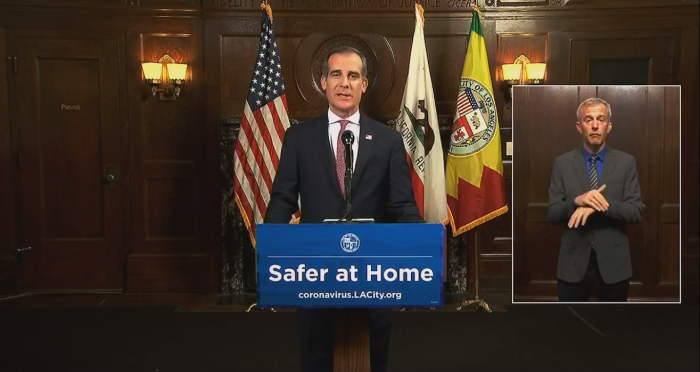
On April 19, Los Angeles Mayor Eric Garcetti presented the 2020 State of the City Address at City Hall. On April 20, the release of Mayor Garcetti’s proposed budget for the 2020-2021 fiscal year, further outlined more of what can be expected, which starts July 1.
While the mayor’s address was underlined with hope, it was also a sobering reality of the city’s current and coming conditions. Despite tough times, he believes much lies in what we do after COVID-19.
“All of us remember the 2008 recession,” said Mayor Garcetti. “Until now, it was the biggest economic blow of our lifetime, and it hurt. But there’s no way to sugarcoat this. This is bigger, and it will hurt more.”
He continued, “Our city revenues have plummeted. Hotel reservations have collapsed. After 9/11, our airport closed for two and a half days, passenger traffic fell by as much as a third that month, and it took 10 years to claw our way back. Today, airport passenger traffic is down 95%.
“From a fiscal perspective, this is the worst it’s ever been.”
Mayor Garcetti addressed that funding for certain departments will definitely feel the affects of the city’s shutdown, but he intends to keep local services intact.
“Soon, many departments will have to operate at sharply reduced strength,” said Mayor Garcetti. “Cherished programs will lose funding, while recreational and community services will see significant changes. We’ll have less to spend on removing graffiti and caring for our urban forest.
“We face sharp limits right now, but I draw a red line around the foundation of our common good — those ‘back to basics’ investments that keep our neighborhoods safe, our streets clean, our families housed, and our children and seniors fed.”
In his address, Mayor Garcetti addressed four questions to Angelenos during this unprecedented time:
1. How will we make it through?
“It may be months before we safely gather in large groups,” said Mayor Garcetti. “It may be a year or more before a vaccine or medicine frees us from periodically returning to safer at home, but I’m so proud of what we have done as a city to stanch the bleeding. Emergency protections like our eviction moratoriums and our rent freeze are helping.
“Our manufacturers have retooled their assembly lines to produce face coverings and essential equipment and keep people at work. Our labs and universities have lent their expertise on testing, tracing, and economic revitalization.
“And our philanthropic community has stood up to ensure that no one gets left behind. With donations large and small, the Mayor’s Fund for Los Angeles has put food on the table and grocery cards in people’s hands; provided childcare for our healthcare workers, meals for our seniors, and beds and safe havens for victims of domestic violence.
“Right now, we’re in the first battle of this fight. Without a vaccine, we will almost certainly see a second wave of this novel coronavirus. But let me be clear: we cannot stay indoors for six or seven months without risking an even greater economic catastrophe.”
2. When can we begin to leave our homes?
“Last week, I laid out the key elements of our return. One, testing both for the virus and for its antibodies.
“Two, real-time dynamic monitoring to see where cases are, followed by three, an immediate tracking and tracing response to quarantine people so that the virus can’t spread to others.
“Four, we need to build and maintain our hospital capacity, both the human talent of nurses, techs and doctors, and the equipment and supplies so they can safely treat the worst cases.
“And five, we need ongoing research & development into treatments and a vaccine for this disease.
“To lead this effort and rebuild our economy, I have proposed the formation of a “CARES Corps” — a coalition of local governments and health agencies, medical professionals and businesses, backed by federal funding and built to combat COVID-19 and to accelerate our economic recovery.
“In the short term, the CARES corps would helm contact tracing efforts, deliver food to vulnerable populations, support testing sites, build and staff shelters, and assist small businesses.
“In the long term, it will address systemic disparities in access to medical services, incentivize careers in high-need fields, train corps members in disaster response, and cross-train individuals from the public, non-profit, corporate, and independent sectors to support essential services during emergencies. It will take advantage of the skills of public workers and put to work unemployed Angelenos.”
3. When we do go back, what damage will have been done?
“At the height of the great recession, our city’s unemployment rate hit 13.4 percent. Today it’s higher. Preliminary numbers for the top of this month show nearly 300,000 Angelenos unemployed. That number will rise.
“Behind those numbers are neighbors, behind those statistics, stories, and it hasn’t fallen upon us equally. Fewer Latinos, Asian Americans, and African Americans have the option of working from home. Many working-class Angelenos of color who could keep working, have had to risk their health by doing so. So, we were among the first cities to protect vulnerable workers by requiring face coverings and hand sanitizer at essential businesses.
“There’s good reason to believe that your actions have flattened this curve, but to be clear, the numbers are still going up. Yesterday, we lost 81 Angelenos. Until our numbers start to shrink, we still have work to do.”
4. When we do return, who do we want to be?
“You see, outside of our homes there is a great city waiting for us. The things we love about L.A. Will persist: our weather, our music, our food and culture, our drive to transform and innovate, our freedom, and what we believe in — the idea that we all belong to a block, a neighborhood, to this entire place, and to one another.
“And while we set the pace for the nation in so many ways, in innovation, in freedom, in belonging, we must ask of our city and our nation, at this time, is normal really what we want to come back to?
“As a city, we haven’t been waiting to take action. We’ve been digging deep, passing record investments like Prop HHH and Measure H to deliver housing, healing, and hope to the unsheltered. But in this crisis, we have a new county-wide plan to find thousands of hotel and motel rooms to prevent the spread of the virus among people experiencing homelessness. And once those fellow Angelenos come inside, they must not return to the streets.
“We passed a moratorium on evictions. But, let us guarantee that the loss of a job need not mean the loss of your home. Let’s back with federal funds a suspension of rent and mortgages during this crisis. Let’s use a massive expansion of Section 8 to create the affordable and the social housing that will end our housing crisis for good.
“Here, we made our College Promise — the largest now in the country — our commitment to making community college free for every LAUSD graduate.
“Let’s build on that nationwide with a promise to make college free for everyone who wants it. Give millions more the opportunity to pursue education as part of our recovery, to attend four-year universities as well as trade schools and community colleges as a way to get ahead, just as the GI Bill after World War II democratized education and wealth.”
Some of the Mayor’s proposed budget focuses on key areas such as:
*COVID-19 response plan
*homelessness
*city safety
*city maintenance
*economic and youth development
*technology
“Strengthening city services, common sense reforms and a culture of problem-solving—these were the keys to building up our economy,” said Mayor Garcetti. “That same solid foundation will help us build it again. After the last recession, we recovered faster than the state, and the state faster than the nation. Los Angeles was a sprinter.
“And that same solid foundation and that same speed can help us do it again.”
Mayor Garcetti didn’t hold back on addressing the reality and results of our current situation, but he didn’t hold back on the real possibility of creating a better tomorrow. He is calling on those in government to help get people working again. He is also proud how Angelenos have stood up to the challenges of COVID-19 and stated that spirit is what will ultimately pull everyone through, not just in L.A., but the country.
“To our friends in Washington, D.C., do what it takes to keep us building,” said Mayor Garcetti. Pass a national infrastructure bill now, so we can put people back to work, and we’ll show the country how to get it done.
“You see, when Los Angeles takes action, we inspire the nation and the world. We’ve led the way by staying home and by raising the wage. We’ve led the way by wearing face coverings and by protecting the undocumented. Those Angeleno cards were followed by California’s $125 million fund to support immigrant families—let’s follow that by opening every part of our recovery to every immigrant no matter their status.
“The soul of our recovery will shape the contours of Los Angeles’ future. We’ve been addressing our biggest problems head-on: homelessness, traffic. So, let’s not just try to recapture the past when we have the blueprint of the city of the future.”
The proposal will be subject to City Council review and approval, which will take place in the coming weeks before a final budget is adopted.
For more on the State of City Address, please visit www.lamayor.org
For more on the budget for the 2020-2021 fiscal year, please visit http://cao.lacity.org








